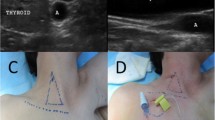Abstract
Objective
The aim of this study was to compare the anatomic-landmark and ultrasound-guided techniques in the placement of an internal jugular vein port in patients with advanced breast cancer.
Methods
Between March 2010 and October 2010, 60 patients with advanced breast cancer underwent central venous port placement for the delivery of chemotherapy, preferably through the internal jugular vein. Patients were randomly assigned to either the anatomic-landmark or the ultrasound-guided group. Failure on first attempt, number of attempts until successful catheterization, time to successful placement, the accordance of the two placement approaches, and the demographics of each patient were recorded.
Results
The consistency of the direction of two lines drawn using the anatomic-landmark and ultrasound-guided techniques or of the diameter of the internal jugular vein as determined by the two approaches was 85% (51/60). The rate of successful placement at first attempt was higher in the ultrasound group than in the anatomic-landmark group (P < 0.05). A greater number of attempts and longer time to successful port placement were needed in the latter (P < 0.05).
Conclusion
The findings of this study indicate that, in the placement of an internal jugular vein port, the ultrasound (US)-guided technique has several advantages over the anatomic-landmark technique.
Similar content being viewed by others
References
Legha SS, Haq M, Rabinowits M, et al. Evaluation of silicone elastomer catheters for long-term intravenous chemotherapy. Arch Intern Med, 1985, 145: 1208–1211.
Ishizuka M, Nagata H, Takagi K, et al. Right internal jugular vein is recommended for central venous catheterization. J Invest Surg, 2010, 23: 110–114.
Mirza B, Vanek VW, Kupensky DT. Pinch-off syndrome: case report and collective review of the literature. Am Surg, 2004, 70: 635–644.
Leung J, Duffy M, Finckh A. Real-time ultrasonographically-guided internal jugular vein catheterization in the emergency department increases success rates and reduces complications: a randomized, prospective study. Ann Emerg Med, 2006, 48: 540–547.
Milling TJ Jr, Rose J, Briggs WM, et al. Randomized, controlled clinical trial of point-of-care limited ultrasonography assistance of central venous cannulation: the Third Sonography Outcomes Assessment Program (SOAP-3) Trial. Crit Care Med, 2005, 33: 1764–1769.
Dudrick SJ, Wilmore DW, Vars HM, et al. Long-term total parenteral nutrition with growth, development, and positive nitrogen balance. Surgery, 1968, 64: 134–142.
Ingram J, Weitzman S, Greenberg ML, et al. Complications of indwelling venous access lines in the pediatric hematology patient: a prospective comparison of external venous catheters and subcutaneous ports. Am J Pediatr Hematol Oncol, 1991, 13: 130–136.
Yip D, Funaki B. Subcutaneous chest ports via the internal jugular vein. A retrospective study of 117 oncology patients. Acta Radiol, 2002, 43: 371–375.
Zhou WP, Wu MC, Yao XP, et al. The effects of combined hepatectomy and immunochemotherapy on postoperative recurrence of primary liver cancer. Chinese-German J Clin Oncol, 2005, 1: 163–165.
Yonei A, Nonoue T, Sari A. Real-time ultrasonic guidance for percutaneous puncture of the internal jugular vein. Anesthesiology, 1986, 64: 830–831.
Randolph AG, Cook DJ, Gonzales CA, et al. Ultrasound guidance for placement of central venous catheters: a meta-analysis of the literature. Crit Care Med, 1996, 24: 2053–2058.
Machi J, Takeda J, Kakegawa T. Safe jugular and subclavian venipuncture under ultrasonographic guidance. Am J Surg, 1987, 153: 321–323.
Funaki B, Szymski GX, Hackworth CA, et al. Radiologic placement of subcutaneous infusion chest ports for long-term central venous access. AJR Am J Roentgenol, 1997, 169: 1431–1434.
Caridi JG, Hawkins IF Jr, Wiechmann BN, et al. Sonographic guidance when using the right internal jugular vein for central vein access. AJR Am J Roentgenol, 1998, 171: 1259–1263.
Beaulieu Y, Marik PE. Bedside ultrasonography in the ICU: part 2. Chest, 2005, 128: 1766–1781.
Troianos, CA, Jobes DR, Ellison N. Ultrasound-guided cannulation of the internal jugular vein. A prospective, randomized study. Anesth Analg, 1991, 72: 823–826.
Author information
Authors and Affiliations
Corresponding author
Rights and permissions
About this article
Cite this article
Rao, N., Wu, J., Li, S. et al. Central venous port placement in advanced breast cancer patients: comparison of the anatomic-landmark and ultrasound-guided techniques. Chin. -Ger. J. Clin. Oncol. 10, 695–698 (2011). https://doi.org/10.1007/s10330-011-0842-3
Received:
Revised:
Accepted:
Published:
Issue Date:
DOI: https://doi.org/10.1007/s10330-011-0842-3




